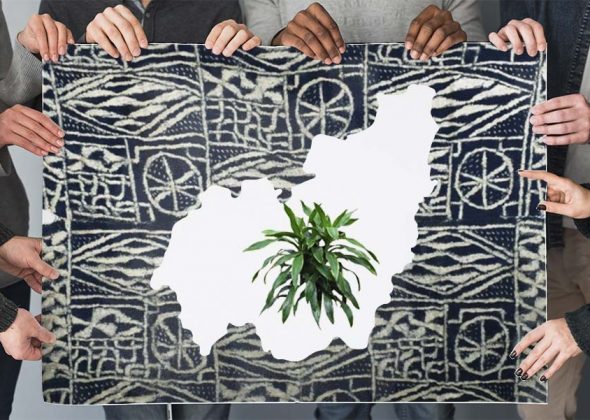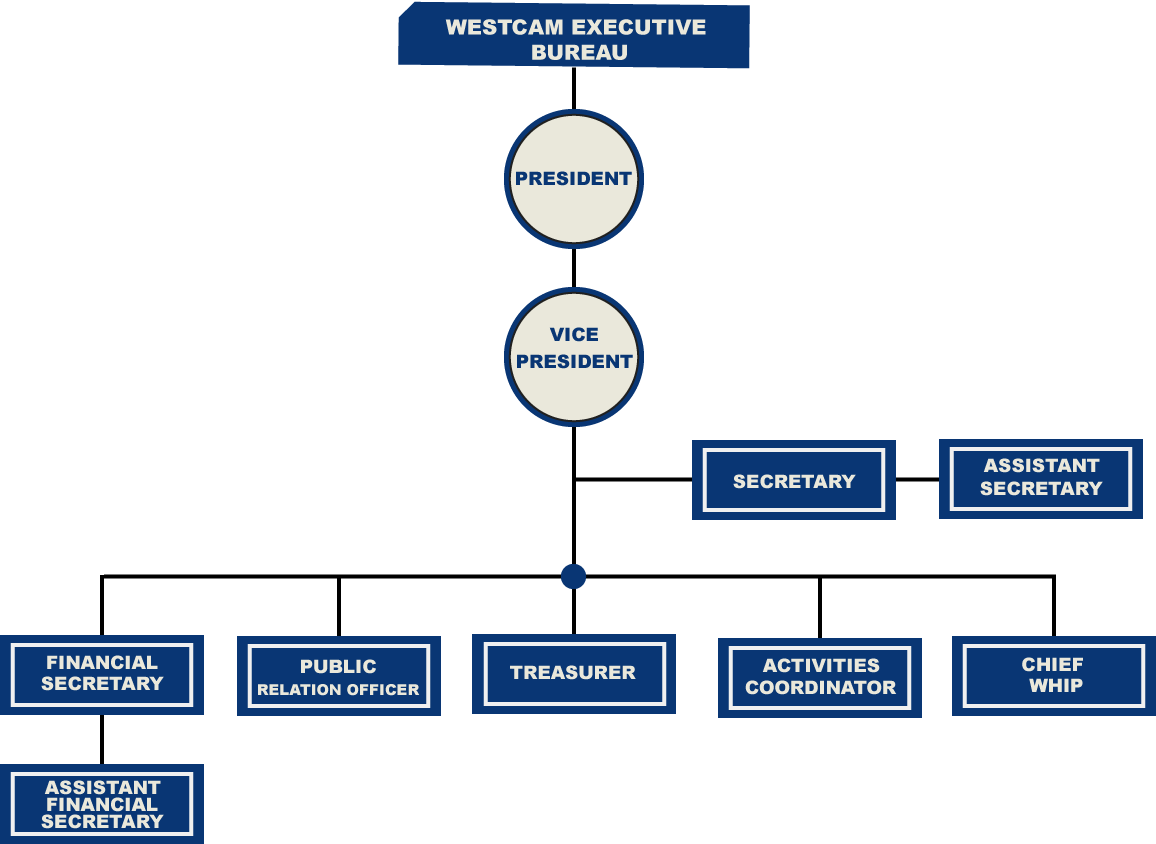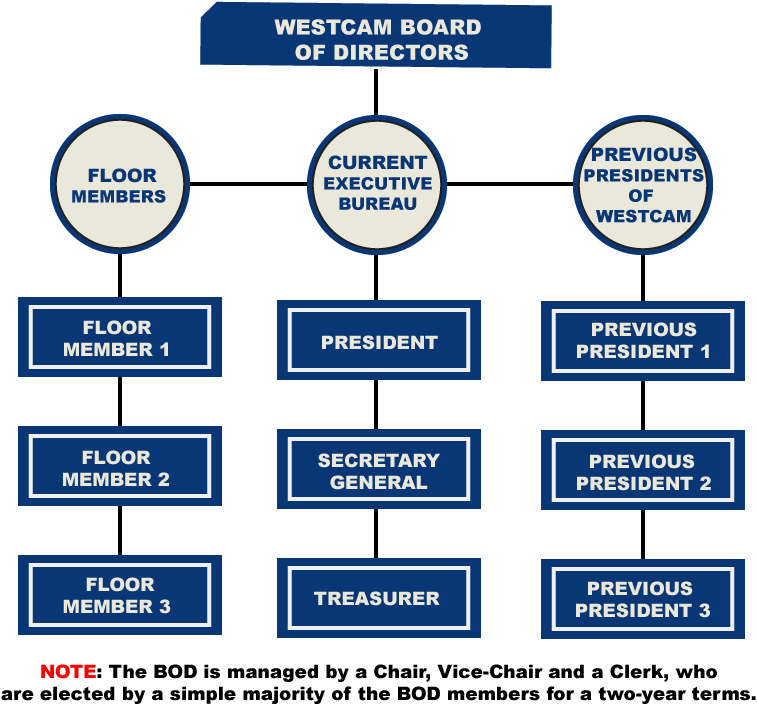WESTCAM Inc.
Our Main Objectives.

OUR LEADERSHIP TEAM
Board Of Directors
The BOD of this organization shall consist of up to 15, but not fewer than 9 members elected by the General Assembly at the Annual Meeting of September or October. The BOD is composed of the following:
The Executive Bureau
The EB is the executive organ of the Association. It shall have all the powers and authority of the board of directors in the 14 intervals between meetings of the BOD, and is subject to the direction and control of the full BOD and the GA.
Audit Committee & Committee of the Wise
In addition to the GA, BOD and EB, our association also include the an Audit Committee (AC) and Committee of the Wise (CW). Read our Bylaws to learn more about these roles and positions.
![]()

[give_form id=”19338″]
BAMILÉKÉ
Some insights about the Bamilékés people of Cameroon
By Paulette Meyitang Ngachoko
________________________________________
• Who are the Bamilékés?
• Where do they come from?
• How do they live?
• And we in the Diaspora, are we conscious of who we are? our origins? our culture? Where are we going?
Brief Note: REMARKS ON AFRICAN HISTORY RICHER THAN 6500 YEARS
Before I go on to tell you more about the Bamiléké, please let me carve out what period we are talking about. We will capture the story and history of the Bamiléké people starting around the 8th century after Christ. This means we are somehow conforming to the mistake that has pervaded the study and history of Africa and Black people in general. Our history like African history in general, is only presented when ancient Egypt is in decline, leaving out glorious years and millenniums of world domination. This perpetuates the idea that we’ve always been defeated and that we as a people have no history of achievement. Historians say the Ancient Egyptian calendar is more than 6500 years old, yet the world has so far mainly focused on the non-glorious part of our history. I opened this parenthesis because it’s important in order to understand the Bamiléké people.
BAMILÉKÉ PEOPLE TODAY:
Nowadays, Bamilékés live mainly in the Western and northwestern regions of Cameroon. Cameroon itself for those who need a reminder is located is west or central Africa, depends on your source. Cameroun is at the heart of Africa and is even called Miniature Africa. Bamiléké form the largest ethnic group in Cameroon, statistics vary depending on the source, but average estimations place the Bamilékés around 25% of the Cameroon, meaning around 6 million people.
Outside their main western and northwestern regions:
They represent around 85% of people in the Mungo region, and more than 70% of the population of Douala. Bamiléké can be found in significant numbers in other large cities of Cameroon like Yaoundé, Ngaoundéré, Giroux, Bertoua, etc.
WHERE DO BAMILÉKÉ COME FROM?
Historically, Bamilékés come from Upper Egypt (Please understand that for ancient Egyptians, Upper land/Egypt meant what is currently southern Egypt…I wonder how we succeeded in two millenniums in reversing the map of the world this way…our ancestors must not be happy about that). According to historians, Bamiléké were part of group of a people called Baladis, still living in Egypt today. The Bamiléké left Upper Egypt between the 8th and 9th century fleeing the arabo- islamic invasion. They arrived in the Tikar region (northern Cameroon) around mid 12th century -1360. They all had one king and after the last common king named Ndeh went to meet his creator and his ancestors they split in a few groups. Before I tell you an interesting story related to this split, let me highlight this.:
The first Prince named Yendé crossed the Noun river to go found his kingdom in Bafoussam, from there will descend all the other kingdoms in the western region. His sister went to create the Banso kingdom in the Bamenda region. Two decades later, the youngest brother named Ncharé settled in the Noun valleys to create the Bamoun kingdom.
Note: So please never ask again why there are Bamilékés in the English speaking region of Cameroon or if Bamenda people are Bamilékés.
Now the story I promised: The division is illustrated by the different attitudes the descendants of King Ndeh adopted when during their escape from the arabo-muslim invasion they came across a geographic obstacle that represented the Noun river in Cameroun.
Ancient Egyptians believed that dark water could bring troubles or bad luck. When they reached a river with water color very dark, it reminded them of their prevailing and deep seated belief. They called the river, Noun. One part of the group refused to cross the river because of course they thought it would bring chaos, problems, bad luck. Those who refused to cross the river stayed and were later caught by the Arabs and converted to Islam. They are called today the BAMUN = Bamoun.
The other group was so adamant about not wanting to be caught by Arabs and convert to Islam that they disregarded their prevailing belief and crossed the river and settled in mountainous (and volcanic) areas of west Cameroon. They were never caught by Arabs and never converted to Islam; they are called today, Bamiléké.
ORIGINS OF THE WORD BAMILÉKÉ:
The origin of the word “Bamiléké” has been subject of long debates and even controversies. Before I tell you about the most probable origin of the word, I would like to present a few other versions. This is important because not only it is related to the origins of our people, it also calls upon us to question our knowledge of our history because it’s been largely told and written by others for us. One example is what colonists said about us and we have blindly adopted as truth when we clearly know that their agenda was never in our interest. Now back to the origin of the word Bamiléké; the first three hypothesis all related to Cameroon colonization seem to explain the origins of the word Bamiléké.
The first version was supported by a gentleman named Prince Mbou. According to him, an interpreter named Elame, during the German colonization accidentally coined the term by calling people from western Cameroon "Baboté ba leke" which literally meant “people who wear masks on their face”. That did not sound true, nor did it really reflect the way Bamiléké people dressed in their daily lives. This version did not bode well with another researcher named Justin Mouafo, a Bamiléké himself.
Justin Mouafo was a former regional Administrator for cultural affairs in the western region and was deemed very knowledgeable about Bamiléké cultural origins. Justin Mouafo said the word "Bamiléké” derives from the Foto language (Menoua region) "Pe me lekeu" which literally means “people living in the mountains and ravines”. This version is the one most people seem to align with. Mr. Mouafo said that during his investigations, he met a former interpreter from Foto named Yalo. Mr. Yalo told him that in March 1916 he welcomed a German Administrator and colonist with whom he took a walk. When they reached a river, there were men fetching water with their hands and drinking. The German asked what they were doing, he said “Menoue” which means “they are drinking”. The white man wrote in his notebook “Menoua” which became the name of the department (county).
Further down the road, they met a group of people who were arguing and the colonist asked again what are they doing and he said “ntsang” which meant ‘a dispute /argument” and the German noted “Dschang”, which became the name of the city. When they got to the hill adjoining today’s University of Dschang, the white man saw houses extending from the valleys to the mountains and asked again what was that; to which the translator said “Pe me lekeu” which literally means “people living in the mountains and ravines.” The German noted Bamiléké. As you have already noted the German administrator was writing sounds that he was capturing all along.
Now a third version: According to a third thesis based on investigations made by a gentleman named Jean Marie Tchegho and published in his book, the word “Bamiléké” derives from, again, the Foto language (Dschang). The word comes from “Ba meleke” which means “the house of white people”. He says the first colonists used to have very distinguished houses. They were different from local houses by the way they were built and the fact that they were well lit which made them stand out. Local people passing by used to say “Ba meleke”. Because colonists heard that word so frequently, they ended up calling all people in the region Bamiléké.
After those three versions, I am going to give you what is thought to be the most probable origin of the word Bamiléké, this sustained by Jean Claude Ka Crhi. Compared to the Bamoun who identify themselves by their ancient Egyptian God Amon/Amoun, Bamiléké identified themselves by their land of origin, Upper Egypt. Bamiléké is a simplified writing and pronunciation by westerners, of the ancient Egyptian expression “Ba Mieh Lah Ke” which is closer to the original guttural pronunciation. “Ba Mieh Lah Ke” mean People from the upper land/region, referring to Upper Egypt.
Ba: means they or people in reference to their geographic origin
Mieh: brothers or siblings
Keh: upper, in reference to upper land or region. Let’s not forget that ancient Egyptians did not call their land Egypt, but Upper or Lower land, which was in fact Kemet which also means “the land of people who are black, who have dark skin”.
To conclude, the debate is not definitively settled, but whether you think Bamiléké means people who live in the mountains and valleys or people who come from Kemet, the upper land, you are right in both cases.
THE BAMILÉKÉ LANGUAGE:
Bamiléké people speak a number of languages with deep similarities, all taking roots from Pharaonic Egypt. Several sources attest to the fact that Bamiléké people spoke one language until their split around mid 14th century and the 15th century. Ancient Egyptians called their language Medu Neter, meaning “Gods language, sacred words” which they eternalized through hieroglyphs. They anticipated their decline and made it in such a way that their descendants will be able to use the language to rebuild their identity after a period of perturbation, disorientation and loss. The Medu Neter survived centuries and millenniums as opposed to other human languages and has preserved it original meaning. Medu Neter survived through Bamiléké languages and others. The “Medu Mba” is the mother language of all Bamiléké languages. “Medu” / Menu/ means words in both languages. Bamiléké languages today can be arranged in five groups:
- Medumba (Banganté)
- Yemba ( Menoua)
- Ngomba (Mbamboutos)
- Nghomala (Bandjoun)
- Fefe’ ( Bafang)
Note: All these groups have numerous sub-variance of languages.
SOCIAL ORGANIZATION:
Nowadays Bamiléké are organized in about a hundred kingdoms all in the western and northwestern region of Cameroon. Most of them split from the original kingdom of Bafoussam. Bangangté for example came about because of split after an argument about succession in the kingdom of Banka (Bafang). One of the princes said “Me hak teuh” meaning I am too great to bow to someone else. He then founded his kingdom along with other people who came from the Noun region.
The Bamiléké society is very organized and hierarchised. You find the king at the top, then the council of seven, the council of nine, the queen mother who plays a very important role in decision making. You then have princes and princesses, as well as other children of the village that distinguish themselves by their achievements.
In each kingdom, we can find many societies that can be regrouped as followed:
- Political and administrative societies; council of the nine “nkemvu” (M’kamvù),
- Warriors’ societies: Mandjoung , les Kù’ gaing
- Religious-magical societies: council of seven “nkemsambia/beu”, Mkamsombeù
- Totemic societies; les Ku’gaing, secret police in relation with invisible forces of nature
- Secret societies: Laakam.
The role of all these societies is mainly to protect the community, ensure the well-being of all; and help the king govern. Most people can gain access to some of these societies (like Mandjoung) by succeeding to an existing member or through merit and by initiation.
MORE ABOUT THE LAAKAM AND ITS IMPORTANCE IN BAMILÉKÉ TRADITION:
Laakam is a place where only the initiated can enter. When the kind dies it is said that he has fallen asleep or that the baobab has fallen. He is secretly buried in the sacred forest named “Fam/Feum” near his palace. One of his children is chosen to replace him. His will is usually confided to another king and only revealed after his passing. The new king is revealed only the day he is supposed to be “arrested/caught”. Only very few notables are made aware before the "arrestation" of the new King. Right after his "arrestation", he enters the sacred place called Laakam where he will be initiated to all rites and customs, as well as the art of leadership. That initiation lasts nine weeks. At the end of this training the new king is installed on his throne. The whole village, as well as kings from neighboring kingdoms come to celebrate. A big feast is organized and the village welcomes its new king.
ECONOMY:
Bamiléké are very dynamic and excel in business. According to Forbes Magazine 7 of the 10 richest people in Cameroon are Bamiléké. They invest in transportation, hotels, gas stations, banking, agriculture and more. They dominate the Cameroonian economy.
The western region and the Mungo department exports agricultural products to Gabon, and Equatorial Guinea. Bamilékés people are very self-reliant; they have savings mechanisms called "Njangui" and because of that, they are able to finance most of their projects themselves. Because of their dynamism and success, Bamilékés sometimes attract jealousy. They are also criticized for their expansionist attitudes, which lead others to call them invaders. As they travel looking for more or better opportunities for their families and communities, they rarely forget their motherland. Every village in Bamiléké land has a day for shopping and the market is usually located at the entrance of the king’s palace. Market day is therefore a day and place for meeting, networking, rejoicing and exchange of information.
BELIEFS AND CULTURE:
BELIEFS:
Bamiléké believe in one God they call "N’Si", our creator. They know that in order to honor God, they have make sacrifices in sacred places. They pray to God through their ancestors. They believe that the most direct route to our creator is through their ancestors. That’s why they practice what is called worship of skulls. Bamilékés also recognize their wind gods that protect different aspects of their lives. They know that their departed ancestors have more power to intercede before God in their favor. Revealed religions only entered Bamiléké culture very recently.. In the traditional Bamiléké spiritual lexicon, we don’t talk about religion, nothing is imposed upon anyone, Jesus, Allah, and Buddha do not exist.
CULTURE:
- Bamiléké culture is very rich and diverse.
- Our culture honors and represent ancestors, totems, war scenes and more
- Our sculpture, painting, house with roof in pyramidal form all reflect the ancient Egyptian civilization.
Bamiléké community in general is characterized by common symbols, whether they find themselves in the western region, the northwestern region or the Bamoun area. Some examples are:
- Ndop
- Dedam
- Nkueken ou Feukeng
- Ndukah
- Kola Nut
- Horse Tail
- Double Nging
There you have in these few lines a brief presentation about the Bamiléké. Bamiléké are united by their origins and their culture, and they strive to preserve that bond. Before we close, there are a few lessons to draw and an assignment for our younger generations specially.
A FEW LESSONS FROM THIS PRESENTATION:
- Never let anyone name you or your child
- Know your ancestors language, that’s the only way you learn about your true history
- Don’t let anyone else write your history for you: they know nothing about you, they may use their own language and distort your history.
- Our history is more than 2000 years old and is full of very glorious achievement
- We still don’t know much about our history because we did not write what we know today ourselves and a lot of what we know so far is misleading
- We have barely scratched the surface or what our true history is, both as Bamiléké and black people in general
- Young people please take the lead and do what your parents have not done yet: go figure it out, there are more and more resources out there to do more and better.
Thank you
Paulette Meyitang Ngachoko
Revision 1 -2020
The New England Bamiléké Assistance (NEBA) Organization is founded on the values of solidarity and the devotion to community. Learn more about NEBA by clicking on the below button.



